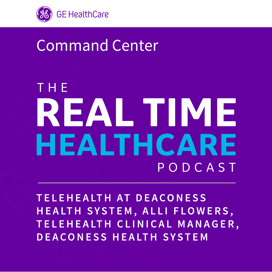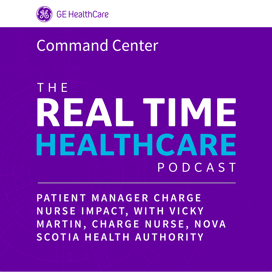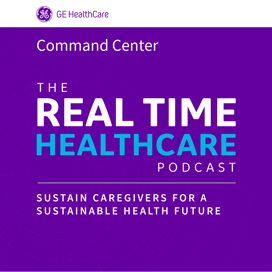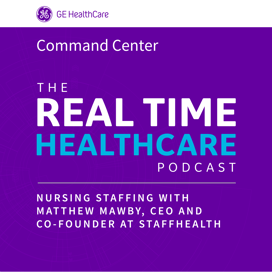#40 - Clinical Deterioration with Bradford Teaching Hospitals NHS Foundation Trust’s Deputy MD, LeeAnne Elliott
Aug 2 · 15:23 min
In this Episode:
In the next installment of the Real Time Healthcare podcast, Becky Knee is joined by LeeAnne Elliot, Deputy Medical Director of Bradford Teaching Hospitals. This is the third podcast in our series on the Patient Deterioration Tile at Bradford Teaching Hospitals.
Becky:
Hello and welcome to the next installment of our Real Time Healthcare podcast. This is the third in our series on patient deterioration at Bradford Teaching Hospital. I'm Becky Knee, I'm the program manager at Bradford Teaching Hospital for the Command Center. And I'm joined today by LeeAnne Elliott, who's the deputy medical director. Thank you very much, LeeAnne, for joining us today.
The patient deterioration Tile is really looking at, where are our most acutely ill patients? So, it takes up all those news two schools, early warning schools, or any other protocols that you might have or choose to use and pulls them into the Tile. So, we can really identify which of our patients are most acutely ill. Are potentially at risk of declining or becoming ill the quickest. Or those people who need a new set of vital signs or observations done, to make sure that they're not becoming worse.
So, it pulls all that information through. It gives a really clear view for caregivers on the wards, in the hospital to see exactly what's happening with that patient. So, thank you very much LeeAnne for joining us. We're going to talk today a little bit about the process of configuring the Tile and rolling it out across the hospital and the experience you've had in that.
So to kick us off, it'd be greatly great to start talking about your experience of how the patient deterioration Tile was co-designed and developed at Bradford.
LeeAnne:
Thanks Becky. When GE started working with us around the command center, we saw a great opportunity to look at the way we could improve the management, escalation and visibility of deteriorating patients. We knew from intelligence, from all other areas within the hospital, that there was an area that we needed to do some improvement on. We worked really closely with GE, but also with a multidisciplinary team from across our acute areas from both medicine and surgery. But, we had involvement from medical staff from nursing staff of a wide range, and really thought about what was important to enable us to recognize patients who were deteriorating, but also to then respond to that deterioration.
It was a really interesting piece of work. It took quite a few months, but I think that work at the very start was really worthwhile. We have a group we call the management of the deterioration group. And, that's sort of our assurance group around managing deterioration in all forms. And that again, is a multidisciplinary group, but they were integral to the work that we did in the planning and really thinking about what was important to know about a patient. And importantly, what was important to the staff on the ward that they could see could be easily accessible and easily managed.
So, although it took a long time, I think that was really worthwhile and really helped us going forward to use the Tile.
Becky:
I think it's really important point you've pulled out that actually this was really done by a clinically led group.
LeeAnne:
Yes, yes.
Becky:
Doctors and nurses, because they are ultimately the people using this Tile. They are the primary users of it, and it hasn't been an IT project. It really has been clinically led.
LeeAnne:
Absolutely. And, I think we always envisaged that the usage of this Tile would be in the wards and departments. So, it was key to us to make sure that we were talking to the people who were going to use it. So if you like the end users. So, that whatever we put into the Tile was going to be useful to them onto the way they worked and improve the outcome for the patient, but also improve the way the staff were working.
Becky:
Yeah, absolutely. I guess, throughout, as you say, it's been quite a long process and along the way, we've probably changed what we've been doing a little bit or made sort of iterations or learnt. How we felt like that process has gone?
LeeAnne:
So I think we have, from the very first inception, we changed quite a lot. Some of that was around what data was actually available in what form and how we could use it. But, some of that was around our understanding of what was important. So, we looked back at where we'd maybe seen problems or where things had gone well and realized quite soon really, what the important features were. In our hospital, we use the news to score and the various physiological parameters that feed into that. But, it was really key working with the staff to understand what was important of those and what was important to know and be visible on the screen.
Becky:
And it hasn't just... Obviously we did the configurations that took a while, had a few iterations, and then we went live with the product on the ward. But, it hasn't ended there. We have continued to make some changes as well, based on feedback that we've had or things that we found that we didn't think were important and then did turn out to be important.
LeeAnne:
Absolutely. And with all the way through this we've tried to use sort of improvement methodology. So we've tested things, we've had a look at what we've got. We've tried it in various areas and if it hasn't worked, we've tweaked it. What has worked we've sort of expanded on it. And, I think one of the really exciting features is that we have been able to make changes and going forward, we will still be able to make changes.
So for an example, we're currently working with the renal team, so that we can add not only around a new score, but out of flag around acute kidney injury around AKI. And, that's really exciting that we can sort of further improve the whole product, the whole visibility for the staff on the ward.
Becky:
Absolutely. And how, in terms of the adoption of the Tile, how did you go about releasing it into the wild as it were?
LeeAnne:
So again, we were quite keen to use improvement methodology. So, our plan do study act and what we did was we released it to a couple of wards to start with. We went really slowly, but we worked with our improvement team. And with in particular, our sepsis nurse. We worked really closely with those couple of wards, to really understand how it was being used and to really learn about how the staff were feeling about it. Were there any barriers? What they liked about it.
One of the key things that I remember about that work was that our health care assistants, it became really obvious that they were the people taking the physiological measurements, but they weren't always acting upon them. And, so for the health care assistants to have visibility of when their patients needed their next new scores, I don't think any of us had really thought about at the start. But, then once we got on the ward and the departments, we realized the importance of that initial measurement and that if we don't get that measurement done at the right time or the right frequency, then we're not going to make any progress going forward.
So, those first two or three wards we worked on, we learned such a lot about how the Tile would be used. Made tweaks along the way and then sort of COVID happened. So when, when COVID happened and like lots of other places, we moved our wards round and staff were working in unfamiliar areas, probably possibly with an unfamiliar team. And, we all agreed that the deterioration Tile, to roll out further was key to helping and supporting staff in those areas that they might be unfamiliar in working with. So, we then did a wider rollout to lots of wards and departments in order to facilitate that we actually put what we call the task force.
So, the deterioration patient task force was put into place. And, that was members of the chief nurses team. I was involved with the quality improvement, but went out to the wards every day and supported the staff in those areas. That in fact worked really well. It did need a lot of support, but it worked really well. The feedback from the staff was amazing that the fact that they could see this information was visible all the time to them. It was really enlightening and it was really pleasing to see actually that all the work we'd been doing had made a difference for the staff on the ward.
Becky:
And, that support sort of shoulder to shoulder is so important in terms of enacting change. It can't just be an email out saying, "Please use this now." But, that constant going back and back and back and helping and supporting. And, the training that's been done has all been really paramount to the success of the adoption and embedding of it in the trust.
LeeAnne:
And that's right. I think we know from our other improvement work that just sending out an email telling people what to do, just doesn't always work. And in this situation, what is required is that task force. Those people actually on the ward, working with the staff and really sort of going through how to use it, so that training element, but also picking up where there were problems and really sorting them out on the shop floor.
I think the other thing we realized that certainly I have realized fully at the star was the IT infrastructure that was required on the wards. And again, this sort of links back to that whole COVID issue in that wards had moved around. The PCs weren't necessarily where staff needed them to be. So, alongside the task force, we did quite a big piece of work with the IT team, making sure that the screens were available, where they needed to be in a place that was visible to the staff who needed to see them.
And again, I think that joint working so this whole project really has been a multidisciplinary approach bringing in all the areas within the hospital. And I think that's worked really well, you just need to involve all the right people.
Becky:
Absolutely, absolutely. And I mean it's been great that it's been so well taken up by staff on the wards and they've come to it so quickly. What kind of impact are you seeing, whether that's sort of impact on staff and their seating and confidence or impact on patient outcome?
LeeAnne:
So, a couple of examples, really. So we have a critical care outreach team. So, that's a team led by the consultant anesthetists and the critical care nurses. In the past, they've sort of known where our unwell patients are likely to be, but they've had to go into each individual ward record in order to see any patients that they might be concerned about. The Tile has enabled that team to have a quick view of the whole hospital. So, we've come up with a terminology, ITU without walls. So, they can see that ITU without walls, they can filter patients by new score, by area, by lots of different parameters. But, they can see where the sickest patients are. And, that has really helped them have visibility, offer support. Even if it's a phone call, "Are you okay? Are you managing?" Or a visit for some advice. That's really, really helped the critical care outreach team.
We're in the process of collecting data to sort of measure our improvement and help to drive it forward. We think that we've actually seen an increase in our arrest calls. But the increase has been in... So, we only have one arrest call number and that's for true arrests and for medical emergencies. We've seen an increase in overall number but the increase has been in that medical emergency. So, people are recognizing deterioration and asking for help using that number. So, we think that's what the data is showing us to start with.
And, so it's really interesting how we've sort of changed that balance and with the support of the critical care outreach team. The other interesting area, I think is going back to the health care assistants.
Becky:
Yes.
LeeAnne:
They really liked to see the visibility of the patients they're looking at. So rather than checking the clock and seeing when the observations that you, they can actually see it on the Tile. And, the ward managers have got really good oversight of all the patients on their ward now around the sickest patients.
Becky:
I think that empowerment for HCAs really important that they can take control and feel that they're in control and that visibility without having to be asked to go and see such and such a patient, or take the observations for such and such a patient, because a nurse is looking at their record and can see that they can do that on their own. And, it makes it much more of a multidisciplinary between working together rather than a sort of strictly hierarchical, which I think is really, really great.
LeeAnne:
Yeah.
Becky:
Excellent. I think that's probably all of our questions for today, unless you have any other final thoughts, LeeAnne and your experience implementing the Tile?
LeeAnne:
I think my experience is that the key has been working directly with the wards and departments to really understand and support staff in both the implementation, but also the continued use. And, as I mentioned previously, the fact that we can make further changes as we go along because we're learning all the time. This isn't a sort of one-off piece of work. I think we'll continue to learn. We'll continue to tweak to make sure that the Tile does really what we want it to do, which is, improve the care of our sickest patients.
Becky:
Absolutely. Excellent. Well, thank you so much for joining us today, LeeAnne. I really appreciate your time.
LeeAnne:
Thank you.
Becky:
Okay.
LeeAnne:
Thank you.
Tiles present and aggregate information gathered from other systems to improve visibility and workflow efficiency, based on hospital defined standards. Tile users have the ability to filter information and organize information for their needs. Tiles do not make clinical determinations and are not intended for patient monitoring.







